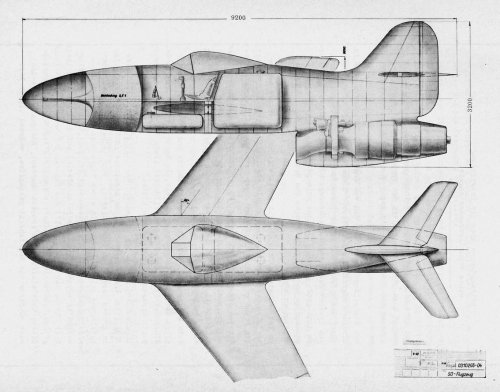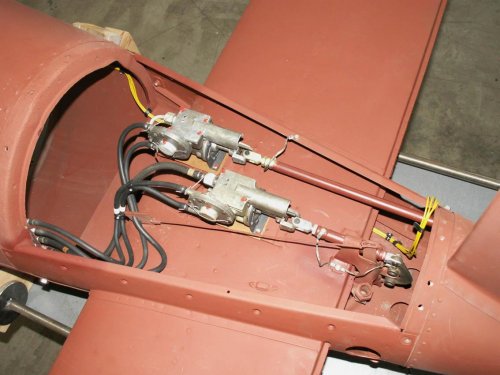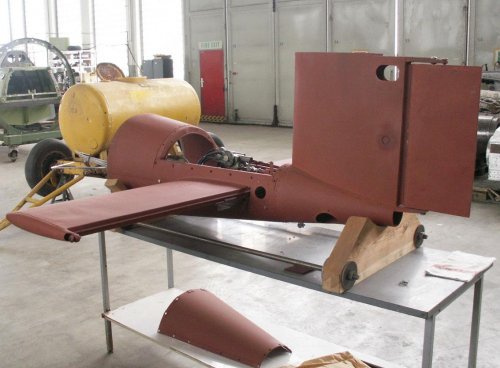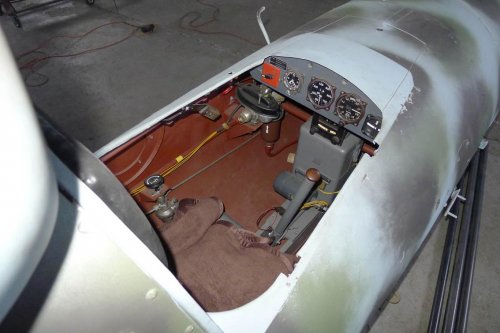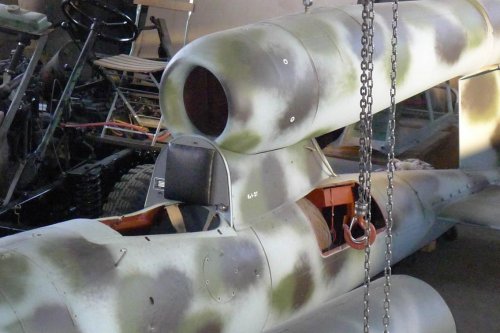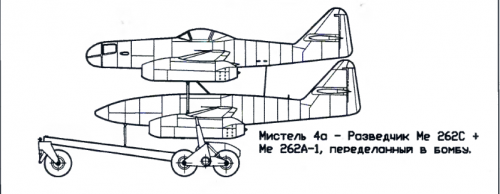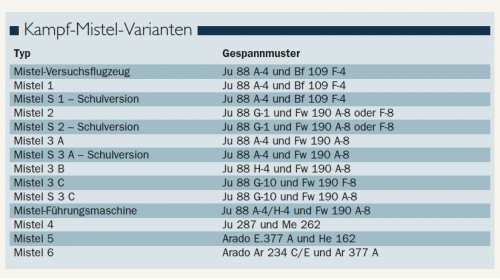aerospace
Homebase: Tempelhof airfield Berlin
The complete discussion in this thread has the same text as three to four pages in an average book. That seems too much for some participants to read. Nevertheless there are some interesting contributions to the discussion I would like to comment:
1) a means of rescue device was always fitted
The Daimler-Benz-SO-jet-bomber for example was meant to destroy convoy-vessel in the mid-Atlantic. If the pilot could manage to bail out over an exploding tanker and could make it into the sea, he has only to swim 2000 km to the German coast to be save. Is that the kind of rescue you are talking of? Seen through your eyes, every Japanese Kamikaze had means of rescue - but what was the impact on the pilot’s mission?
In 2014 I could talk to one surviving SO-pilot, than 92 years old. He volunteered as most of his comrades from a glider-unit for the Reichenberg. With a short-span glider Stummelhabicht they trained to attack clouds in two ways. A near vertical dive as a direct attack on a target and a cut-under attack to simulate the torpedo-like warhead against ships. He never flew a Reichenberg before the unit was disbanded and he was transferred to a fighter squadron. They were treated like being "living deaths", best food, accommodation and entertainment and it was promised that the nation would take care for their families. The moral was very high. But it was said that if they refuse to fly an ordered mission they would have been shot. He told me, that was no problem to the volunteers, all had accepted death -"it was a very different time".
2) Why not just convert a manned Me 262?
That is a good idea! With the new Jumo 004 C a 262 must have been able to carry around 3 tons of bomb-load. This would have been sufficient for the SO-purpose. The issue must have been the time it takes to develop a sub-type of an existing aircraft. New load factors and changes to the airframe causes a lot of new computations and tests for loads, elastics and flutter-safety. So the quick solution is to take two completely designed and certified aircraft and combine them.
3) What was the gain in payload from adding the Reichenberg?
The duty was not to add some more payload to the 262-bomb, but to add a pilot that would guide the explosive 100 percent into the target.
4) There is not enough space within the fuselage of the ‘Reichenberg’ to install the instruments
If you would have ever looked into a Reichenberg cockpit you would have recognized that there is a lot of space for the two Jumo-controls needed. Please see Re_cockpit_01.jpg.
5) The fast disconnection system between both airplanes would have been very complex
Letting beside that there is no disconnection, it would have been not more complex than for other Mistel!
6) It does not make much sense to risk two highly valuable turbojets and a well trained Me 262 pilot in a suicide mission
If it does not make sense to you, please see point 12. It could make sense to other people in previous times and a different situation.
7) it would have been much more efficient to use another Me 262 as piloted airplane capable to return to base with the pilot alive?
Yes - now you got it! That are two different approaches. That is what we talked of when discussing the Me262/Me262-Mistel. When this 262/262 has been on the drawing-boards, what advantage could have a new designed Reichenberg/Me262-Mistel? Only that one flies with a returning pilot and the other in a SO-mission.
8) If this type of Mistel would try to fly with turbojets and pulsejets working SIMULTANEOUSLY, the vibration of the Argus would destroy the connecting struts.
I must mention that I am part of a small group restoring ww2 aircraft and missiles and so have worked for the Luftwaffe-museum at Berlin-Gatow to restore their V-1. Yes, the Schmidt-Argus is vibrating, but it is more the noise that causes problems. See picture Fi103_01.jpg and Fi103_02.jpg that show the pneumatic control system of this guided bomb that is very sensitive to vibration and has to be very accurate to bring the Fi 103 into the target area. It works directly under the running engine who's mount is depicted at right. And please compare the cockpit-picture of Alexander Kuncze's fine restored Reichenberg, where the brain of the pilot is even closer to the engine - destroyed by vibrations?
For more Fi 103 pictures please visit:
www.daedalus-berlin.de (sorry - text only in german).
9) the Argus had a useful life of just 20 minutes.
Yes, the Schmidt-Argus has a short life time. That is why I suppose that this engine is running on full power only at take-off and during the attack. For cruise it must be powered down. Otherwise the mistel would make no use of the Me 262's longer range.
10) It would also not have had much strategic sense trying to sink one of the 72 aircrafts carriers the Allies had at the beginning of 1945. This was a time to destroy bridges to stop the Red Army.
I have never been a commander of an army. But I would imagine that concentrating only on a single issue would mean to lose the battle. If the bombers continue to destroy factory after factory and city after city - there is nothing left to defend and you would have no weapons for your soldiers.
11) I'll try to explain, why it may not have been a "SO-Gerät"
Do not argue what it is not - bring arguments what it is. I am looking forward reading your analysis!
12) suitable as an area weapon
What could a young man 1944 motivate to fly a suicide-mission? Take only one small excerpt from the document of the Daimler-Benz-SO-jet-bomber: "… with one man as a Self-Sacrifyer and with a charge of 2.5 tons in the fuselage-nose …" "… operated for the combat against vessel-targets, especially for the destruction of tank-vessels . A single destroyed tanker of 15 000 tons causes the loss of fuel for 3 full size bomber attacks against Germany to the enemy." "The thought to sacrifice one single man and a single aircraft ... to prevent 3 of such full size bomber attacks is to my judgment a respectable one."
Everybody in Germany remembered the Hamburg-raid of 1943, where 3 bomber attacks killed around 35 000 civilians, wounded around 125 000 and destroyed one of the oldest towns in Germany within two days.
Does someone here has even the slightest doubt that in 1944 there had been enough men willing to exchange their life to save thousands or up to 35 000 civilians? Captured allied crews and documents clearly proofed that the only target of the "Operation Gomorrha" was to kill as many civilians as possible and to cause terror and fear. Captured crews later stated that it was the plan of the Allies to "Hamburgize" every major city in Germany. And Dresden was still to come.
"Area weapon" - what a nonsense! Thousands of such aircraft approaching London? What would motivate this pilots? To destroy the bathroom of the King at Buckingham Palace?
1) a means of rescue device was always fitted
The Daimler-Benz-SO-jet-bomber for example was meant to destroy convoy-vessel in the mid-Atlantic. If the pilot could manage to bail out over an exploding tanker and could make it into the sea, he has only to swim 2000 km to the German coast to be save. Is that the kind of rescue you are talking of? Seen through your eyes, every Japanese Kamikaze had means of rescue - but what was the impact on the pilot’s mission?
In 2014 I could talk to one surviving SO-pilot, than 92 years old. He volunteered as most of his comrades from a glider-unit for the Reichenberg. With a short-span glider Stummelhabicht they trained to attack clouds in two ways. A near vertical dive as a direct attack on a target and a cut-under attack to simulate the torpedo-like warhead against ships. He never flew a Reichenberg before the unit was disbanded and he was transferred to a fighter squadron. They were treated like being "living deaths", best food, accommodation and entertainment and it was promised that the nation would take care for their families. The moral was very high. But it was said that if they refuse to fly an ordered mission they would have been shot. He told me, that was no problem to the volunteers, all had accepted death -"it was a very different time".
2) Why not just convert a manned Me 262?
That is a good idea! With the new Jumo 004 C a 262 must have been able to carry around 3 tons of bomb-load. This would have been sufficient for the SO-purpose. The issue must have been the time it takes to develop a sub-type of an existing aircraft. New load factors and changes to the airframe causes a lot of new computations and tests for loads, elastics and flutter-safety. So the quick solution is to take two completely designed and certified aircraft and combine them.
3) What was the gain in payload from adding the Reichenberg?
The duty was not to add some more payload to the 262-bomb, but to add a pilot that would guide the explosive 100 percent into the target.
4) There is not enough space within the fuselage of the ‘Reichenberg’ to install the instruments
If you would have ever looked into a Reichenberg cockpit you would have recognized that there is a lot of space for the two Jumo-controls needed. Please see Re_cockpit_01.jpg.
5) The fast disconnection system between both airplanes would have been very complex
Letting beside that there is no disconnection, it would have been not more complex than for other Mistel!
6) It does not make much sense to risk two highly valuable turbojets and a well trained Me 262 pilot in a suicide mission
If it does not make sense to you, please see point 12. It could make sense to other people in previous times and a different situation.
7) it would have been much more efficient to use another Me 262 as piloted airplane capable to return to base with the pilot alive?
Yes - now you got it! That are two different approaches. That is what we talked of when discussing the Me262/Me262-Mistel. When this 262/262 has been on the drawing-boards, what advantage could have a new designed Reichenberg/Me262-Mistel? Only that one flies with a returning pilot and the other in a SO-mission.
8) If this type of Mistel would try to fly with turbojets and pulsejets working SIMULTANEOUSLY, the vibration of the Argus would destroy the connecting struts.
I must mention that I am part of a small group restoring ww2 aircraft and missiles and so have worked for the Luftwaffe-museum at Berlin-Gatow to restore their V-1. Yes, the Schmidt-Argus is vibrating, but it is more the noise that causes problems. See picture Fi103_01.jpg and Fi103_02.jpg that show the pneumatic control system of this guided bomb that is very sensitive to vibration and has to be very accurate to bring the Fi 103 into the target area. It works directly under the running engine who's mount is depicted at right. And please compare the cockpit-picture of Alexander Kuncze's fine restored Reichenberg, where the brain of the pilot is even closer to the engine - destroyed by vibrations?
For more Fi 103 pictures please visit:
www.daedalus-berlin.de (sorry - text only in german).
9) the Argus had a useful life of just 20 minutes.
Yes, the Schmidt-Argus has a short life time. That is why I suppose that this engine is running on full power only at take-off and during the attack. For cruise it must be powered down. Otherwise the mistel would make no use of the Me 262's longer range.
10) It would also not have had much strategic sense trying to sink one of the 72 aircrafts carriers the Allies had at the beginning of 1945. This was a time to destroy bridges to stop the Red Army.
I have never been a commander of an army. But I would imagine that concentrating only on a single issue would mean to lose the battle. If the bombers continue to destroy factory after factory and city after city - there is nothing left to defend and you would have no weapons for your soldiers.
11) I'll try to explain, why it may not have been a "SO-Gerät"
Do not argue what it is not - bring arguments what it is. I am looking forward reading your analysis!
12) suitable as an area weapon
What could a young man 1944 motivate to fly a suicide-mission? Take only one small excerpt from the document of the Daimler-Benz-SO-jet-bomber: "… with one man as a Self-Sacrifyer and with a charge of 2.5 tons in the fuselage-nose …" "… operated for the combat against vessel-targets, especially for the destruction of tank-vessels . A single destroyed tanker of 15 000 tons causes the loss of fuel for 3 full size bomber attacks against Germany to the enemy." "The thought to sacrifice one single man and a single aircraft ... to prevent 3 of such full size bomber attacks is to my judgment a respectable one."
Everybody in Germany remembered the Hamburg-raid of 1943, where 3 bomber attacks killed around 35 000 civilians, wounded around 125 000 and destroyed one of the oldest towns in Germany within two days.
Does someone here has even the slightest doubt that in 1944 there had been enough men willing to exchange their life to save thousands or up to 35 000 civilians? Captured allied crews and documents clearly proofed that the only target of the "Operation Gomorrha" was to kill as many civilians as possible and to cause terror and fear. Captured crews later stated that it was the plan of the Allies to "Hamburgize" every major city in Germany. And Dresden was still to come.
"Area weapon" - what a nonsense! Thousands of such aircraft approaching London? What would motivate this pilots? To destroy the bathroom of the King at Buckingham Palace?

